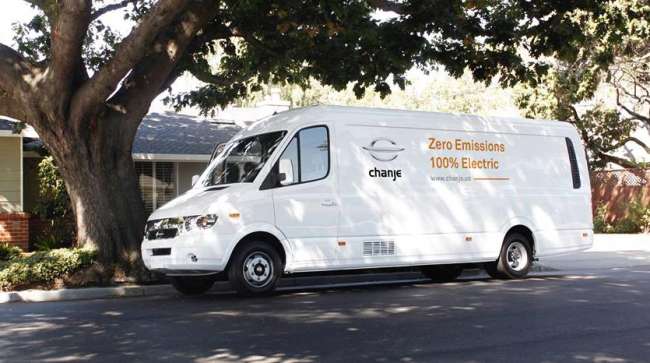A New All-Electric Delivery Truck Is on the Way, and It’s Not From Tesla

Chanje’s vision sounds a lot like Tesla’s: electric vehicles recharged via clean rooftop solar power.
But the new company has no interest in the automobile market. Instead, it’s entering what it believes to be a lucrative niche in medium-duty electric trucks.
Few such trucks exist. Most medium-duty electric trucks are internal-combustion vehicles hand-converted to run on electric motors and batteries.
Chanje’s trucks are not concept vehicles or prototypes. They’re ready for sale, and the Los Angeles company plans to begin selling or leasing them within weeks.
“We decided, let’s show up when we’re ready to go to market,” said Bryan Hansel, founder and chief executive.
RELATED: Tesla meets with California, Nevada on autonomous truck testing
He wouldn’t get specific on pricing, but contends that monthly lease amounts will be “at parity” with leases for diesel-engine competitors once lower maintenance costs and net fuel savings are figured in. He said buyers of such trucks consider price and financial return above all other considerations.
You see medium-duty trucks making deliveries all over the city: UPS step vans, snack-food delivery trucks, sketchy vehicles covered in graffiti containing who knows what. There are about 7 million of them in the United States, and about 500,000 are sold each year, said Antti Lindstrom, an analyst at IHS Markit.
Chanje intends to ride what it sees as the increasing popularity of electric powertrains. The big risk for the company, Hansel acknowledges, is “how fast people will make that transition.”
We’re a California-based OEM delivering medium duty EVs & turnkey energy infrastructure services for the last https://t.co/RyKv1fGMJT pic.twitter.com/umaRhNmta4 — Chanje (@ChanjeEnergy) August 10, 2017
The company’s future depends not only on the U.S. market, but the market for electric trucks in China. Chanje is 49% owned by Hong Kong-based FDG, a maker of battery cells, battery packs and vehicles in China. Already, FDG has sold a couple of thousand Chanje vehicles in China, Hansel said, under the brand name Chang Jiang.
Those vehicles, built in a 4 million-square-foot factory in Hangzhou, China, are shuttle buses. But the underlying platform on all Chanje vehicles was designed to be easily lengthened or shortened to accommodate vehicles of different lengths and body styles.
The trucks Chanje plans to sell in the U.S. are smaller than the big-rig, semitruck cabs that Tesla intends to build. Those trucks, which Tesla is expected to announce next month, will reportedly come with some self-driving capability and will encounter skepticism in trucking circles that batteries can efficiently power trucks that big.
Tesla Chief Executive Elon Musk has also hinted at a pickup truck in Tesla’s future, but nothing about a medium-duty entry.
The first few hundred trucks sold by Chanje will be imported from the Hangzhou plant. But the company eventually plans to important kits from China and assemble them in the U.S., first in the West and, if things go well, then in the Midwest and the East Coast. Chanje is now combing Western states for a manufacturing site.
Although a start-up, Chanje’s roots go back to a company called Smith Electric Vehicles, which began building electric trams in the 1920s. It later supplied electric ice cream trucks, electric milk trucks and other delivery vehicles, but not in large numbers.
In 2009, under Hansel, the company was consolidated and based in Kansas City, where it tried to commercialize medium-size electric trucks. By 2015, it had ceased operations.
“This is a real interesting evolution for this company,” said Mike Ramsey, auto industry analyst at Gartner. “They broke into this market a bit too soon. But they had a model that really makes sense.”
That model is to sell into the delivery market, where routes typically run 50 to 70 miles a day, well within an electric battery’s range. Range on current Chanje vehicles is about 100 miles.
The difference between a few years ago and now, Ramsey said, is that battery costs have come way down and continue to fall. FDG making batteries in China will help keep costs down, he said, and China sales will spread fixed costs.
“The only way to scale is to have a global product,” Hansel said.
Even if operating costs are lower (no oil change, brakes last longer, electricity is cheaper than diesel) it will be a challenge to persuade big buyers such as UPS or FedEx to make the huge capital expenditures needed to transform their fleets, Ramsey said.
UPS ranks No. 1 and FedEx No. 2 on the Transport Topics Top 100 list of the largest U.S. and Canadian for-hire carriers.
But Joerg Sommer, Chanje’s chief operating officer, said 70% of medium-size truck buyers have fleets of 20 vehicles or less. And the bigger buyers will be watching those initial purchasers to see whether the operating costs justify them making a switch.
Meantime, Sommer said, Chanje is planning to provide energy systems for large fleet buyers — the solar roofs, for example.
The company is positioned for rich subsidies from California taxpayers. Right now, buyers of medium-sized electric trucks qualify for thousands of dollars in state subsidies.
Subsidies “will help accelerate our expansion. But we don’t see it as a long-term strategy,” said James Chen, the company’s general counsel. “Any viable business needs to stand on its own.”




